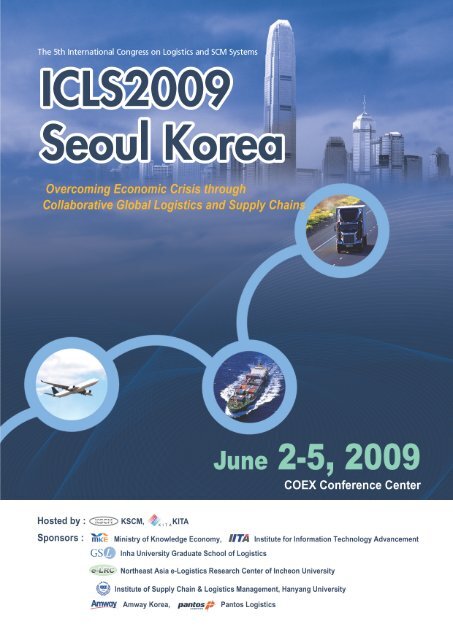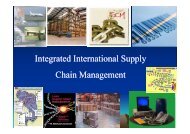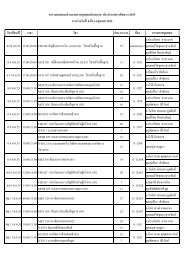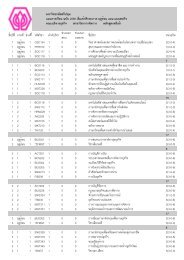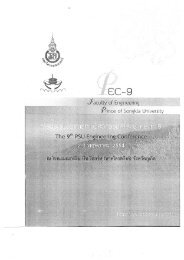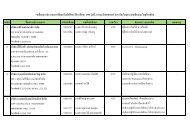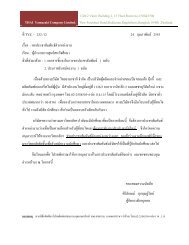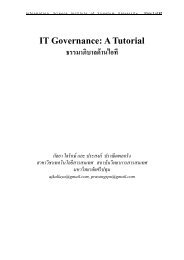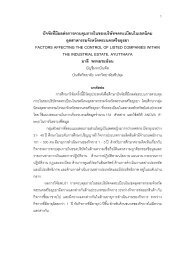ICLS2009 Seoul Korea Table of contents
ICLS2009 Seoul Korea Table of contents
ICLS2009 Seoul Korea Table of contents
You also want an ePaper? Increase the reach of your titles
YUMPU automatically turns print PDFs into web optimized ePapers that Google loves.
<strong>ICLS2009</strong> <strong>Seoul</strong> <strong>Korea</strong><br />
<strong>Table</strong> <strong>of</strong> <strong>contents</strong><br />
June 3(Wed), 2009<br />
[ Keynote Speech 1 ]<br />
K01 "Emerging Trends <strong>of</strong> Supply Chain Management in the United States"<br />
Pr<strong>of</strong>. Hokey Min(Bowling Green State University, USA)<br />
[Opening Ceremony]<br />
Opening Address<br />
Welcome Address<br />
Congratulatory address<br />
[ Keynote Speech 2 ]<br />
K02 "A World Class Supply Chain Management Strategy from the Experience in Singapore"<br />
Pr<strong>of</strong>. Mark Goh(National University <strong>of</strong> Singapore)<br />
[Supply Chain Strategy 1]<br />
A01( icls011)<br />
A Study <strong>of</strong> Strategic optimization for Logistics & SCM in Automotive industry<br />
Nyeonsik Choi, Gyunghyun Choi(Hanyang University, <strong>Korea</strong>)<br />
A02(icls029)<br />
Success Factor Analysis <strong>of</strong> Supplier Development : A Case study <strong>of</strong> Hard Disk Drive manufacturer in<br />
Thailand<br />
Arunee Eiampreecha, Montalee Sasananan(Thammasat University, Thailand)<br />
A03( icls038)<br />
Roles <strong>of</strong> Senior Executives for Global Supply Chain Management: A Brief Review and Illustrations<br />
Paul Hong(University <strong>of</strong> Toledo, USA), He-Boong Kwon Concord University, USA), Youngwon Park Waseda<br />
University, Japan), Jihye Lee SK Research Institute, <strong>Korea</strong>)<br />
A04( icls046)<br />
Supplier Selection for Strategic Purchasing and the case study <strong>of</strong> a South <strong>Korea</strong>n Elevator<br />
Manufacturer<br />
Dong Myung Lee(Konkuk University, <strong>Korea</strong>), Paul R. Drake(University <strong>of</strong> Liverpool Management School,<br />
UK)
A05(icls049)<br />
Smart Label-supported Autonomous Supply Chain Control in the Apparel Industry<br />
Scholz-Reiter, B.; Teucke, M.; Özsahin, M.-E.; Sowade(University <strong>of</strong> Bremen, Germany)<br />
[Supply Chain Performance 1]<br />
B01(icls014)<br />
Measuring the bullwhip effect in a supply chain with stochastic lead time and seasonal ARMA<br />
demand processes<br />
Dong Won Cho, Young Hae Lee(Hanyang University, <strong>Korea</strong>)<br />
B02(icls017)<br />
A Study on the Effectiveness <strong>of</strong> Vendor-managed Inventory in the Two-echelon Retail Supply Chains<br />
Sung-Chul Hong( CJ GLS Inc., <strong>Korea</strong>),Yang-Byung Park( Kyung Hee University, Rep. <strong>of</strong> <strong>Korea</strong>)<br />
B03(icls109)<br />
Analyzing the Dysfunction <strong>of</strong> Shared Information<br />
Yongwon Seo(Chung-Ang University, <strong>Korea</strong>)<br />
B04(icls054)<br />
A Study <strong>of</strong> Business Performance through Key Performance Indicators (KPIs) in Thai Garment<br />
Industry<br />
Suthathip Suanmali, Ekkprawatt Phong-arjarn, Chawalit Jeenanunta,Veeris Ammarapala(Thammasat<br />
University, Thailand), Kornthip Watcharapanyawong(Kasetsart University,Thailand)<br />
B05(icls070)<br />
On Evaluation and Improvement <strong>of</strong> Supplier Performance: An Effort for Mapping the Management<br />
Knowledge<br />
Arief A.R. Setiawan, Hiroshi Katayama(Waseda University, Japan)<br />
[Logistics Planning & Control 1]<br />
C01(icls019)<br />
Logistic <strong>of</strong> Household Hazardous Waste in Thailand,Case study: Nontaburi Province<br />
Sirawan Ruangchuay Tuprakay(Suan Dusit Rajabhat University, Thailand),<br />
Seree Tuprakay(Ramkhamhaeng University, Thailand)
C02( icls056)<br />
Theory <strong>of</strong> Constraints for Recycling Automobile Tires in the Reverse Logistics System<br />
Yuxiang Yang(Zhejiang University <strong>of</strong> Technology, P.R.China),<br />
Hokey Min(Bowling Green, USA), Gengui Zhou((Zhejiang University <strong>of</strong> Technology, P.R.China)<br />
C03( icls057)<br />
A Study <strong>of</strong> Efficient Recovery Methods for Consumer Electronic End-<strong>of</strong>-Life products in <strong>Korea</strong> and<br />
Japan<br />
Hyunsoo Kim, Daehee Han (Kyonggi University, <strong>Korea</strong>),<br />
Yuji Yano, Gyeonghwa Hong(Ryutsu Keizai University)<br />
C04(icls062)<br />
Logistics Competitiveness in Emerging Countries:the VISTA Case<br />
Yen-Chun Jim Wu(National Sun Yat-Sen University, Taiwan) ,<br />
Hsiao-Ting Huang(National Kaohsiung First University <strong>of</strong> Science & Technology, Taiwan)<br />
C05(icls067)<br />
Factor Analysis on Overseas Offshoring <strong>of</strong> Japanese Automotive Industry by Logit Model<br />
Hisashi Isahaya(Waseda University, Japan), Shunpei Osawa, Norio Ishiwatari, Mitsunobu Yoshino,Osamu<br />
Kurashige(Sankyu Inc., Japan)Hiroshi Katayama( Waseda University, Japan)<br />
[Emerging Technologies for Airport Operation]<br />
D01(icls127)<br />
Efficient ETV Systems For Air Cargo Terminals<br />
Sanghyeon Kim, Junjae Chae, Yoonseok Chang(<strong>Korea</strong> Aerospace University, <strong>Korea</strong>)<br />
D02(icls128)<br />
Airside Movable Objects Pattern Analysis based on Multi-dimensional Clustering<br />
Sang-Hyun OH(Java Information Technology Co., <strong>Korea</strong>),<br />
Jae-Hyun HAN(The <strong>Korea</strong> Transport Institute, <strong>Korea</strong> )<br />
D03(icls129)<br />
Time Delay Reduction System for GSE vehicles in Airside<br />
Jae-Hyun HAN , Yo-Sik KIM(The <strong>Korea</strong> Transport Institute, <strong>Korea</strong>)<br />
D04(icls130)<br />
RFID application environment for air cargo operation<br />
Yoon Seok Chang, Min Gyu Son(<strong>Korea</strong> Aerospace Univ., <strong>Korea</strong>), Doo Won Lee(KPC, <strong>Korea</strong>)
[Supply Chain Strategy 2]<br />
A06( icls050)<br />
Critical factors and barriers in the implementation <strong>of</strong> customer relationship management<br />
Chien-Ta Bruce Ho(National Chung Hsing University, Taiwan),<br />
Kevin Cheng, Bose Sanjoy (New York Institute <strong>of</strong> Technology, United Arab Emirates)<br />
A07( icls058)<br />
Valuing Supply Contract under Real Options Approaches<br />
Phounsakda Phimphavong, Matsumaru Masanobu(Tokai University, Japan)<br />
A08(icls065)<br />
Relevance <strong>of</strong> Lean Management for Global Operations -Issues Learnt from Cambridge Lean<br />
Management Workshop-<br />
Hiroshi Katayama (Waseda University, Japan)<br />
A09(icls085)<br />
Effect <strong>of</strong> Initial Conditions <strong>of</strong> Beer Game in a Supply Chain<br />
Kyoung Jong Park(Gwangju University, <strong>Korea</strong>)<br />
A10(icls090)<br />
Elucidating the effect <strong>of</strong> outsourcing on the supplier relationship<br />
Kevin Shihping Huang (National Sun Yat-sen University, Taiwan),<br />
Yu-Tang Lo ( National Sun Yat-sen University, Taiwan),<br />
Lopin Kuo (Tamkang University, Taiwan)<br />
A11( icls091)<br />
SCM – Quick Implementation to Compete in the Crisis Time. Case Study in Telecom Company<br />
Adelaide dos Santos Figueiredo, José Eduardo Fernandes(Universidade Católica de Brasília, Brazil)<br />
[Supply Chain Performance 2]<br />
B06(icls071)<br />
Improvement <strong>of</strong> Supply Performance between Parts Warehouse and Assembly Plant through<br />
Simulation :Lean Initiatives in Design and Operation <strong>of</strong> Automotive Parts Logistics<br />
Chong Wei Chua( Waseda University, Japan), Yousuke Takahashi (Honda Motor Co., Ltd), Hiroshi<br />
Katayama( Waseda University, Japan)<br />
B07(icls105)
Supply Chain Dynamic Network Equilibrium Model with Electronic Commerce<br />
Li Chunfa, Xu Shiqin, Li Hongwei(Tianjin University <strong>of</strong> Technology, P.R.China)<br />
B08( icls118)<br />
Congestion Analysis through Empirical Survey <strong>of</strong> Container Terminal Gate<br />
Hyung Rim Choi, Jae Joong Kim, Jung Rock Shon, Sung Pill Choi, Chae Soo Kim, Joong Jo Shin(Dong-A<br />
University, <strong>Korea</strong>)<br />
B09(icls093)<br />
Analyzing IOS Impact from SME Supplier Perspective<br />
Choi Young-Jin ( Eulji University, <strong>Korea</strong>) Hyun-Soo Han(Hanyang University, <strong>Korea</strong>)<br />
B10( icls098)<br />
An Empirical Study on Trust, Relationship Behavior and Firm Performance in Global Supply Chain <strong>of</strong><br />
<strong>Korea</strong>n IT Exporting Firms<br />
Hee Cheol Moon(Chungnam National University, <strong>Korea</strong>),<br />
Beom-Soo Park (Electronics and Technology Research Institute, <strong>Korea</strong>),<br />
Jing Xing(Chungnam National University, <strong>Korea</strong>)<br />
B11(icls013)<br />
Multilevel Postponement: Collaborating For Extreme Product Flexibility with High Inventory Turns<br />
William T. Walker(StarTrak Systems, LLC, Morris Plains, New Jersey, USA)<br />
[Logistics planning & Control 2]<br />
C06(icls073)<br />
Reverse Logistics for End-<strong>of</strong>-Life Consumer Electronic Appliances in <strong>Korea</strong><br />
Tai Woo Chang, Tae Young Hur, Hyun Soo Kim(Kyonggi University, <strong>Korea</strong>)<br />
C07( icls084)<br />
Real-time logistic process invocation based on RFID events using CEP engine<br />
Shuzhu Zhang , Hyerim Bae(Pusan National University, <strong>Korea</strong>)<br />
C08( icls080)<br />
Service Planning <strong>of</strong> an Air Cargo Distribution Center with Discrete Event Simulation<br />
Henry Y. K. Lau, Bill K. P. Chan(The University <strong>of</strong> Hong Kong),<br />
Steve K. K. Chan(Hong Kong Air Cargo Terminals Limited, Hong Kong)
C09(icls095)<br />
Lean Logistics Service Providers: Option or Utopia? Experiences from the Netherlands<br />
Job de Haan, Mark Overboom ,Fons Naus(Tilburg University, Netherlands)<br />
C10( icls119)<br />
Exploring Reserve logistics in the Computer Industry – Australian Case Studies<br />
Shams Rahman, William Ong(RMIT University, Australia)<br />
C11( icls115)<br />
Research and Application on Visual Simulation <strong>of</strong> Production Logistics System <strong>of</strong> Coal Mine<br />
Feng Xiwen(Shandong University <strong>of</strong> Science and Technology, China)<br />
Zhao Zhongling(Shandong University <strong>of</strong> Science and Technology, China)<br />
Qu Mianyou(Shandong University <strong>of</strong> Science and Technology, China)<br />
[Modeling & Optimization]<br />
D05(icls018)<br />
A Subproblem Based Compromised Large-Scale Neighborhood Heuristic for Capacitated Air-Cargo<br />
Loading Planning with Fixed Commissions<br />
Yanzhi Li(City University <strong>of</strong> Hong Kong), Yi Tao Fan Wang(Sun Yat-Sen University, China)<br />
D06(icls020)<br />
An Integer Programming Formulation <strong>of</strong> a University Timetabling Problem<br />
Khaled El-Sahli, Fatma Kablan( Garyounis University, Libya)<br />
D07(icls022)<br />
Economic Production Lots for Deteriorating Items with Investing on Production Processes<br />
Ping-Hui Hsu(De Lin Institute <strong>of</strong> Technology, Taiwan),<br />
Hui-Ming Teng(Chihlee Institute <strong>of</strong> Technology, Chung Yuan Christian University, Taiwan),<br />
Hui Ming Wee(Chung Yuan Christian University, Taiwan)<br />
D08(icls030)<br />
Planning <strong>of</strong> Loading-Unloading Spaces Based on Agent-Based Simulation<br />
Yuichi Oyama(Kanagawa Institute <strong>of</strong> Technology, Japan),<br />
Shingo Wakamatsu(CATS CO.,LTD. Japan),<br />
Nobunori Aiura(Kanagawa Institute <strong>of</strong> Technology, Japan),<br />
Yutaka Karasawa(Kanagawa University, Japan), Shigeyuki Yamabe(Tokyo University, Japan)
D09(icls031)<br />
Development <strong>of</strong> Sales Forecasting Model for Farmers’ Markets<br />
Ma Xin,Uetake Toshifumi, Horikawa Mitsuyoshi, Takeno Takeo, Sugawara Mitsumasa (Iwate Prefectural<br />
University, Japan)<br />
D10(icls034)<br />
Optimal Ordering Decisions with Returns and Shortages Backordering<br />
Hui-Ming Teng(Chihlee Institute <strong>of</strong> Technology, Chung Yuan Christian University, Taiwan),<br />
Ping-Hui Hsu ( De Lin Institute <strong>of</strong> Technology, Taiwan)<br />
Yu-Fang Chiu,Hui Ming Wee(Chung Yuan Christian University, Taiwan)<br />
June 4(Thu), 2009<br />
[ Keynote Speech 3 ]<br />
K03 "Meeting Supply Chain Challenges in Global Economic Stress"<br />
Pr<strong>of</strong>. Ik-Whan G. Kwon(Saint Louis University)<br />
[ Keynote Speech 4 ]<br />
K04 "Sustainable Supply Chain: Concept and Perspective"<br />
Pr<strong>of</strong>. Bongju Jeong(Yonsei University)<br />
[ Keynote Speech 5 ]<br />
K05 " Green SCM in turbulent economy”<br />
Mr. Won Joon Hyoung(CEO & President, SAP <strong>Korea</strong>)<br />
[Vehicle Routing and Transportation 1]<br />
A12(icls074)<br />
An Adaptive Memetic Algorithm for Dynamic Vehicle Routing Problems<br />
Hongfeng Wang(Northeastern University, P. R. China), Il-Kyeong Moon(Pusan National University, <strong>Korea</strong>),<br />
Dingwei Wang(Northeastern University, P. R. China)<br />
A13(icls075)<br />
A Study on Dock Door Assignment for Cross-docking Terminal with Multiple estinations in a Single<br />
Dock<br />
Ferdinand Friska Natalia, Geun Hwa Song, Hae Kyeong Lee, Chang Seong Ko (Kyungsung University,<br />
<strong>Korea</strong>)
A14(icls092)<br />
Genetic Algorithm for Workload Capacity Planning with Stochastic Service Time<br />
Chawalit Manisri(Sripatum University, Thailand)<br />
A15( icls076)<br />
Heuristic Procedure for Vehicle Routing Problem with Manual Materials Handling (VRPMMH)<br />
Prachaya Boonprasurt, Suebsak Nanthavanij(Thammasat University, Thailand)<br />
A16(icls068)<br />
Solving a Vehicle Routing Problem with Uncertain Number <strong>of</strong> Vehicles and Time Windows by Multiobjective<br />
Genetic Algorithm<br />
Shunsuke Suganuma, ReaKook Hwang(Waseda University, Japan),<br />
Shunpei Osawa, Norio Ishiwatari, Mitsunobu Yoshino,<br />
Osamu Kurashige(Sankyu Inc., Japan), Hiroshi Katayama(Waseda University, Japan)<br />
[Logistics Network]<br />
B12( icls023)<br />
A Boltzmann random key-based Genetic Algorithm for Flexible Logistics Network Model with<br />
Inventory<br />
Shinichiro Ataka, Byungki Kim, Mitsuo Gen(Waseda University, Japan)<br />
B13(icls024)<br />
Designing Multi-product and Multi-time Period Logistics Network with Inventory by Hybrid Genetic<br />
Algorithm<br />
Mitsuo Gen, Su-jin Jin, Jeong-eun Lee(Waseda University, Japan)<br />
B14(icls026)<br />
Genetic Algorithm for Reverse Logistics Networks Problem in Product Reuse System: A Case Study<br />
Jeong-Eun Lee, Mitsuo Gen(Waseda University, Japan ),<br />
Kyong-Gu Rhee(Dongeui University, <strong>Korea</strong>)<br />
B15(icls035)<br />
Advantage Analysis <strong>of</strong> the Global Supply Network Configuration using Air-Cargo Logistics Center in<br />
the Free Trade Zone<br />
Jun-Der Leu, Yu-Tsung Huang(National Central University, Taiwan)<br />
B16( icls116)<br />
Simulation Analysis on the Air Cargo Network<br />
Dongjin Ko, Kwanryul Lee, Chulung Lee(<strong>Korea</strong> University, <strong>Korea</strong>)
[Planning & Scheduling 1]<br />
C12(icls088)<br />
Spatial Characteristics in Aggregate and Dump Truck Industry<br />
Seung-Bum Ahn, Won-Dong Lee, S. Y. Lim(Univ. <strong>of</strong> Incheon, <strong>Korea</strong>)<br />
C13( icls027)<br />
Quay Crane Scheduling considering Yard Cranes Workload by Multiobjective Genetic Algorithm<br />
Yang Yang(Waseda University, Japan), Kap Hwan Kim(Pusan National University),<br />
Mitsuo Gen(Waseda University, Japan)<br />
C14(icls048)<br />
Optimization Model <strong>of</strong> Hydro and Thermal Electricity Generation System for Daily Load Dispatch<br />
Scheduling<br />
Anwida Prompijit, Chawalit Jeenanunta, Aussadavut Dumrongsiri, Somrote Komolavanij,<br />
Pisal Yenradee(Thammasat University, Thailand)<br />
C15(icls053)<br />
Improve: A New Approach for Solving the Machine Part Cell Formation Problem<br />
Houda Elmogassabi(Garyounis University, Libya)<br />
C16(icls066)<br />
A Procedure for Kaizen Case Development with Related Technology Assets: A Case <strong>of</strong> Visual<br />
Management<br />
Koichi Murata(Waseda University, Japan), Takashi Imamura(Yamatake Corporation, Japan),<br />
Hiroshi Katayama(Waseda University, Japan)<br />
[Vehicle Routing and Transportation 2]<br />
D11(icls096)<br />
Effect <strong>of</strong> Getting Backhaul Loads in Short-to-Medium Range Transportation<br />
Keizo Wakabayashi, Akihiro Watanabe(Nihon University, Japan),<br />
Yu Fujita(SANNO University, Japan), Yutaka Karasawa(Kanagawa University, Japan),<br />
Susumu Ishii(Nihon University, Japan)
D12(icls097)<br />
Effect Analysis <strong>of</strong> Abandonment pallet Causing at Public Truck Terminal by VSP Method<br />
Akihiro Watanabe, Keizo Wakabayashi(Nihon University, Japan),<br />
Yu Fujita(SANNO University, Japan), Yutaka Karasawa(Kanagawa University, Japan),<br />
Susumu Ishii(Nihon University, Japan)<br />
D13(icls059)<br />
An Analysis on the Preference for Mutual Development <strong>of</strong> Busan North Port and New Port<br />
Gyeong-Gu Lee(<strong>Korea</strong> Maritime University, <strong>Korea</strong>), Ju Tae Kan(Busan Port Authority, <strong>Korea</strong>)<br />
Ki-Chan Nam, Kyu-Seok Kwak(<strong>Korea</strong> Maritime University, <strong>Korea</strong>)<br />
D14(icls060)<br />
Performance analysis <strong>of</strong> quay crane systems in seaport container terminals<br />
Pyung Hoi Koo(Pukyong National University, <strong>Korea</strong>)<br />
D15(icls079)<br />
A Hybrid Evolutionary Algorithm for Optimal Container Repositioning<br />
Henry Y. K. Lau(The University <strong>of</strong> Hong Kong, Hong Kong)<br />
Eugene Y. C. Wong(Orient Overseas Container Line Limited, Hong Kong)<br />
[Plant & Warehouse Management]<br />
A17(icls125)<br />
Warehouse Optimization with Visibility : Heesuk Kang(emFrontier)<br />
A18( icls041)<br />
Towards a Sustainable RFID Value in the Supply Chain: RFID based performance management<br />
Yoon Min Hwang, Jae Jeung Rho(<strong>Korea</strong> Advanced Institute <strong>of</strong> Science and Technology, <strong>Korea</strong>)<br />
A19(icls131)<br />
Pantos change logistics: K.C.Park (Pantos Logistics Co.,Ltd., <strong>Korea</strong>)<br />
A20(icls078)<br />
Determining the Number <strong>of</strong> Logistics Resources in Warehouse System Using Simulation: A case<br />
study<br />
Dong Sik Kim , Young Hae Lee, Dong Won Cho( Hanyang University, <strong>Korea</strong>)
A21(icls083)<br />
A Basic Research for an Opportunity Loss <strong>of</strong> the Automated Warehouse Caused by Distribution<br />
Y. Nakama(Sumitomo Heavy Industry, Japan), Y. Karasawa(Kanagawa University, Japan)<br />
K. Wakabayashi(Nippon University, Japan),<br />
N. Aiura(Kanagawa Institute <strong>of</strong> Technology, Japan)<br />
A22(icls101)<br />
Performance Comparison <strong>of</strong> Different Warehouse Layouts under a Class-based Storage Policy<br />
Natanaree Sooksaksun, Voratas Kachitvichyanukul(Asian Institute <strong>of</strong> Technology, Thailand), Dah-Chuan<br />
Gong(Chung Yuan Christian University, Taiwan)<br />
A23(icls077)<br />
Use <strong>of</strong> RFID and Activity-Based Costing in Direct Labor Budgeting<br />
Lawrence Yang(Youric Consultant, Inc., Taiwan ),<br />
Yen-Chun Jim Wu(National Sun Yat-Sen University, Taiwan)<br />
[Supply Chain Strategy & Risk Management]<br />
B17( icls040)<br />
An Entropy Approach to Assessment <strong>of</strong> Small-Businesses’ Credit Based On Daily Transaction Data<br />
DONG Yanwen, HAO Xiying(Fukushima University, Japan)<br />
B18(icls124)<br />
SCM Success Factors and Performance regarding Middle and Down Streams <strong>of</strong> Textiles and Fashion<br />
Business<br />
Sangmoo Shin(Soongsil University, <strong>Korea</strong>), Jin-Hyeok Choe(Soongsil University, Graduate school, <strong>Korea</strong>)<br />
B19(icls104)<br />
Materials management for remanufacturing purpose in closed loop supply chain<br />
Paulina Golinska(Poznan University <strong>of</strong> Technology, Poland)<br />
B20(icls121)<br />
A Review <strong>of</strong> the Roles <strong>of</strong> Suppliers in Large Scale System Integration: A Proposal for New<br />
Paradigm for Supply Chain Management<br />
Seong-Jong Joo(Colorado State University-Pueblo,USA), Ik-Whan G. Kwon(Saint Louis University, USA),<br />
Seock-Jin Hong(Bordeaux Management School, France)<br />
B21(cls015)<br />
Risk Management for Logistics Outsourcing under Public Emergency<br />
FENG Shaojuan, HU Zhenbang(Wuhan Economics Institute, China)
B22(icls037)<br />
Effective Governance <strong>of</strong> Global Supply Chain Risks: A Research Framework and Lessons from Case<br />
Studies<br />
Paul Hong(University <strong>of</strong> Toledo, USA), Youngwon Park, Hideaki Miyajima(Waseda University, Japan), Sachin<br />
Modi(University <strong>of</strong> Toledo, USA),Takeshi Abe(Parametric Technology Co., Japan)<br />
[Planning & Scheduling 2]<br />
C17(icls069)<br />
A Performance Evaluation <strong>of</strong> Job Sequencing for Mixed-model Assembly Line: A Comparison with<br />
Target Chasing Method<br />
Rea Kook Hwang , Hiroshi Katayama(Waseda University, Japan)<br />
C18(icls081)<br />
Multi-Chip Package (MCP) Scheduling Problem in Semiconductor Manufacturing<br />
Yong-Hee Han ( Samsung Electronics, <strong>Korea</strong>), Jin Young Choi(Ajou University, <strong>Korea</strong>)<br />
C19(icls082)<br />
SCM Approach to the Mixed-model Sequencing Problem<br />
Shusaku Hiraki(Hiroshima Shudo University, Japan)<br />
C20(icls086)<br />
Batch family scheduling model under setup and maintenance constraints in the Semiconductor<br />
manufacturing<br />
Jun-Ho Lee, Sun Hoon Kim, Young Hoon Lee(Yonsei University, <strong>Korea</strong>)<br />
C21(icls126)<br />
Design and Implementation <strong>of</strong> Workflow Based Yard Management System<br />
Dong Won Cho, Young Hae Lee, Hyun Jin Hwang(Hanyang University, <strong>Korea</strong>)<br />
C22(icls120)<br />
A comparative study on the perception <strong>of</strong> logistics service quality by shippers, logistics service<br />
providers and service type<br />
Pal-Seon Jang,Oh Kyoung Kwon(Inha University, <strong>Korea</strong>)
[Vehicle Routing and Transportation 3]<br />
D16(icls112)<br />
<strong>Korea</strong>’s Port Development Strategy to be a World Top-class Hub Port in Global SCM<br />
Gim Jin-Goo(LSE INSTITUTE, <strong>Korea</strong>)<br />
D17(icls039)<br />
Algorithm for the Multi-Objective Vehicle Routing Problem with Time Windows<br />
Tharinee Manisri(Sripatum University, Thailand),<br />
Anan Mungwattana(Kasetsart University, Thailand), Gerrit K. Janssens(Hasselt University, Belgium)<br />
D18(icls102)<br />
Key Elements <strong>of</strong> Cross-border Transportation Infrastructure: A Comprehensive Approach <strong>of</strong> Logistics<br />
Infrastructure Development<br />
Pichet Sooksaksun, Wutthipong Moungnoi, Santi Charoenpornpattana(King Mongkut’s University <strong>of</strong><br />
Technology Thonburi, Thailand)<br />
D19(icls108)<br />
Container Terminal Location Model Using Set-covering Method<br />
Suk Tae Bae, Ki Wook Lee, Chang Sung Ha,Heung Suk Hwang(TongMyong Univ., <strong>Korea</strong>)<br />
D20(icls055)<br />
Innovative load carrier management solution for seaport terminals<br />
-based on positioning, identification and communication technologies-<br />
Bernd Scholz-Reiter, Marc-André Isenberg, Anne Virnich, Mehmet-Emin Özsahin(University <strong>of</strong> Bremen,<br />
Germany)<br />
D21(icls113)<br />
A Study <strong>of</strong> e-RTGC Introduction Effects in the Container Terminal: Based on D Container Terminal<br />
Case Study<br />
Hyung Rim Choi, Yong Sung Park, Moo Hong Kang, Seung Hong Lee, Hee Yoon Kim,<br />
Ki Nam Choi(Dong-A University, <strong>Korea</strong>)
The 5th International Congress on Logistics and SCM Systems(<strong>ICLS2009</strong>)<br />
Algorithm for the Multi-Objective Vehicle Routing<br />
Problem with Time Windows<br />
Tharinee Manisri *A , Anan Mungwattana *B , and Gerrit K. Janssens *C<br />
*A Sripatum University, Thailand, e-mail:tharinee_i@hotmail.com<br />
*B Kasetsart University, Thailand, e-mail:fenganm@ku.ac.th<br />
*C Hasselt University, Belgium, e-mail: gerrit.janssens@uhasselt.be<br />
Abstract<br />
This paper focuses on an algorithm for the<br />
vehicle routing problem with time windows<br />
(VRPTW). It involves servicing a set <strong>of</strong> customers,<br />
with earliest and latest time deadlines, a constant<br />
service time including when the vehicle arrives to the<br />
customers. The demands are served by capacitated<br />
vehicles with limited travel times to return to the<br />
depot. The purpose <strong>of</strong> this research is to develop a<br />
hybrid algorithm that includes a heuristic, a local<br />
search and a meta-heuristic algorithm to solve<br />
optimization problems with multiple objectives. The<br />
first priority aims to find the minimum number <strong>of</strong><br />
vehicles required and the second priority aims to<br />
search for the solution that minimizes the total travel<br />
time. The algorithm performances are measured with<br />
two criteria: quality <strong>of</strong> solution and running time.<br />
A set <strong>of</strong> well-known benchmark data and the<br />
genetic algorithm are used to compare the quality <strong>of</strong><br />
solution and running time <strong>of</strong> the algorithm,<br />
respectively. The algorithm is applied to solve the<br />
Solomon’s 56 VRPTW benchmarking problems<br />
which have 100-customer instances. The results show<br />
that 22 solutions are better than or competitive as<br />
compared to the best solutions <strong>of</strong> the Solomon<br />
benchmark problem instances. The running time<br />
results display that the hybrid algorithm has higher<br />
performance than the genetic algorithm when the<br />
number <strong>of</strong> customers less than 25 nodes.<br />
Keywords: Vehicle routing problem with time<br />
windows, Heuristic, Local search, Meta-heuristic<br />
1. Introduction<br />
The vehicle routing problem (VRP) is an<br />
operational decision problem for the delivery <strong>of</strong><br />
goods from a depot to customers by a fleet <strong>of</strong><br />
vehicles. The vehicle routing problem with time<br />
windows (VRPTW) is an extension <strong>of</strong> the VRP with<br />
earliest, latest, service times for customers and travel<br />
times.<br />
The objective is to minimize the number <strong>of</strong><br />
vehicles and the total travel time to service the<br />
customers by using an evolutionary hybrid algorithm.<br />
This paper proposes a multi-objective algorithm that<br />
incorporates a heuristic, local search and a<br />
meta-heuristic for solving the multi-objective<br />
optimization in VRPTW. The algorithm is designed<br />
by the modified push-forward insertion heuristic<br />
(MPFIH), a λ-interchange local search descent<br />
method (λ-LSD) and tabu search (TS). The route is<br />
constructed based on the MPFIH as initial solution<br />
which is improved by using the λ-LSD and TS. The<br />
constraints <strong>of</strong> the problem are to service all the<br />
customers within the earliest and latest service time<br />
<strong>of</strong> the customer without exceeding the route time <strong>of</strong><br />
the vehicle and overloading the vehicle. The route<br />
time <strong>of</strong> the vehicle is defined as the sum <strong>of</strong> the<br />
waiting times, the service times and the travel times.<br />
A vehicle that reaches a customer before the earliest<br />
time, after the latest time and after the maximum<br />
route time incurs waiting time, tardiness time and<br />
overtime, respectively. The total <strong>of</strong> the customer<br />
demands in each route can not exceed the total<br />
capacity <strong>of</strong> the vehicle.<br />
The rest <strong>of</strong> this paper is organized as follows.<br />
Section 2 reviews relevant VRPTW and algorithms.<br />
Section 3 presents tools and the methods to solve this<br />
problem. Section 4 presents the results and<br />
discussion. Finally, conclusions and future work are<br />
formulated in section 5.<br />
2. Literature Review<br />
The VRPTW arises in retail distribution, school<br />
bus routing, mail and newspaper delivery, airline and<br />
railway fleet routing and scheduling. It is well-known<br />
and complex combinatorial problem with<br />
considerable economic significance [1]. Savelsbergh<br />
[2] has shown that finding a feasible solution to the<br />
traveling salesman problem with time windows<br />
(TSPTW) is a NP-complete problem. Therefore the<br />
VRPTW is more complex as it involves servicing<br />
customers with time windows using multiple vehicles<br />
that vary with respect to the problem. By this case,<br />
almost researchers tend to heuristic and metaheuristic<br />
methods which <strong>of</strong>ten produce optimal or<br />
near optimal solutions in a reasonable amount <strong>of</strong><br />
computer time. Thus, there is still a considerable<br />
interest in the design <strong>of</strong> new heuristics for solving<br />
large-sized practical VRPTW.<br />
Evaluation <strong>of</strong> any heuristic and meta-heuristic<br />
method is subject to the comparison <strong>of</strong> a number <strong>of</strong>
The 5th International Congress on Logistics and SCM Systems(<strong>ICLS2009</strong>)<br />
criteria that relate to various aspects <strong>of</strong> algorithm<br />
performance [3]. Examples <strong>of</strong> such criteria are<br />
running time, quality <strong>of</strong> solution, ease <strong>of</strong><br />
implementation, robustness and flexibility [4].<br />
Almost all algorithms for the VRPTW use route<br />
construction, route improvement or methods that<br />
integrate both route construction and route<br />
improvement. Solomon [5] designed and analyzed a<br />
number <strong>of</strong> route construction heuristics, namely: the<br />
savings, time-oriented nearest neighbor insertion and<br />
a time oriented sweep heuristic for solving the<br />
VRPTW. In his study, the time-oriented nearest<br />
neighbor insertion heuristic has shown to be very<br />
successful. Berger and Barkaoui [1] proposed a<br />
parallel version <strong>of</strong> a new hybrid genetic algorithm for<br />
the VRPTW. This approach is based upon the<br />
simultaneous evolution <strong>of</strong> two populations <strong>of</strong><br />
solutions focusing on separate objectives subject to<br />
temporal constraint relaxation. Bräysy and Gendreau<br />
[3] presented a survey <strong>of</strong> the research on the VRPTW.<br />
Both traditional heuristic route construction methods<br />
and recent local search algorithm are examined in<br />
Part I. Meta-heuristics are general solution<br />
procedures that explore the solution space to identify<br />
good solutions and <strong>of</strong>ten embed some <strong>of</strong> the standard<br />
route construction and improvement heuristics [6].<br />
Recently, several researches involve algorithms to<br />
solve the multi-objective VRPTW. The primary<br />
objective is defined as the minimization <strong>of</strong> the<br />
number <strong>of</strong> routes or vehicles. Minimization <strong>of</strong> the<br />
total travel cost is the secondary objective. Qi and<br />
Sun [7] proposed an improved algorithm based on the<br />
ant colony system (ACS), which hybridized with<br />
randomized algorithm (RACS-VRPTW). For this<br />
multi-objective problem, Ombuki et al.[8] presented a<br />
genetic algorithm solution using the Pareto ranking<br />
technique. An advantage <strong>of</strong> this approach is that it is<br />
unnecessary to derive weights for a weighted sum<br />
scoring formula. An evolutionary algorithm for the<br />
VRPTW was developed by incorporating various<br />
heuristics for local exploitation in the evolutionary<br />
search and the concept <strong>of</strong> Pareto’s optimality [9].<br />
All approaches in the literature are quite<br />
effective, as they provide solutions competitive with<br />
the well-known benchmark data, thus the benchmark<br />
Solomon’s 56 VRPTW instances with 100 customers<br />
[10].<br />
3. Tools and Methods<br />
3.1 Tools<br />
The experiments for the research are run on<br />
personal computer, Pentium 4 3.40 GHz. and using<br />
MATLAB computing s<strong>of</strong>tware.<br />
3.2 Notation<br />
K : total number <strong>of</strong> vehicles, k = 1,2,...<br />
K<br />
: lower bound <strong>of</strong> the number <strong>of</strong> vehicles,<br />
K<br />
LB<br />
where K<br />
N<br />
∑<br />
d<br />
i=<br />
LB<br />
= 2<br />
qk<br />
i<br />
N : total number <strong>of</strong> customers, including the depot<br />
Ci<br />
: customer i , where i = 2,3...,<br />
N<br />
C1<br />
: depot<br />
d<br />
i<br />
: demand <strong>of</strong> customer i<br />
Dk<br />
: total demand for the vehicle k<br />
qk<br />
: capacity <strong>of</strong> vehicle k<br />
tij<br />
: travel time between customer i to customer j<br />
where i , j = 1,...,<br />
N , i ≠ j and i , j = 1 is<br />
depot<br />
ei<br />
: earliest arrival time at customer i<br />
li<br />
: latest arrival time at customer i<br />
Ai<br />
: arrival time to customer i<br />
bi<br />
: service time at customer i<br />
w : waiting time between customer i and j<br />
ij<br />
where w<br />
ij<br />
= max[ e<br />
j<br />
− ( Ai<br />
+ tij<br />
),0]<br />
,<br />
i , j = 2,...,<br />
N and i ≠ j<br />
M<br />
k<br />
: maximum route time, where k = 1,2,...<br />
K<br />
Rk<br />
: vehicle route k , where k = 1,2,...<br />
K<br />
Wk<br />
: total waiting time for vehicle k ,<br />
where k = 1,2,...<br />
K<br />
Bk<br />
: total service time for vehicle k ,where<br />
k = 1,2,...K<br />
Ok<br />
: total overtime for vehicle k ,where<br />
k = 1,2,...K<br />
Lk<br />
: total tardiness for vehicle k ,where<br />
k = 1,2,...K<br />
Tk<br />
: total travel times for vehicle k ,where<br />
k = 1,2,...K<br />
Tot<br />
k<br />
: total travel time for vehicle k ,or<br />
Tot<br />
k<br />
= Tk<br />
+ Wk<br />
+ Bk<br />
where k = 1,2,...<br />
K<br />
α : penalty weight factor for the waiting time<br />
γ : penalty weight factor for the tardiness time<br />
η : penalty weight factor for the overtime
The 5th International Congress on Logistics and SCM Systems(<strong>ICLS2009</strong>)<br />
We consider a set <strong>of</strong> vehicles, K and a set <strong>of</strong><br />
customer nodes, C<br />
i<br />
. We identify C<br />
1<br />
as the depot<br />
node and C = Ci ∪ C1<br />
represent the set <strong>of</strong> all nodes.<br />
Let x be the set <strong>of</strong> the decision variables, they are<br />
evaluated using the function F(x)<br />
as equation (1):<br />
F ( x)<br />
= Tk<br />
+ ( α × Wk<br />
) + ( γ × Lk<br />
) + ( η × Ok<br />
) (1)<br />
3.3 Methods<br />
In this paper develops the hybrid algorithm.<br />
There are two phases <strong>of</strong> this algorithm. The first<br />
phase is route construction heuristic, namely, the<br />
modified push-forward insertion heuristic (MPFIH).<br />
The MPFIH is a heuristic method for inserting a<br />
customer into a route based on push-forward insertion<br />
method <strong>of</strong> Solomon [5] and Thangiah [11][15]. It is<br />
an efficient method for computing the insertion <strong>of</strong> a<br />
new customer into the route. Let us assume a route<br />
R<br />
k<br />
= { Cik<br />
,..., Cmk<br />
} where Cik<br />
is the first set <strong>of</strong><br />
customer and C<br />
mk<br />
is the last set <strong>of</strong> customer in each<br />
route k . The earliest arrival and latest arrival time<br />
are defined as e<br />
ik<br />
, lik<br />
and e<br />
mk<br />
, lmk<br />
respectively.<br />
The number <strong>of</strong> routes k in this method is defined as<br />
the minimum <strong>of</strong> number <strong>of</strong> vehicles that satisfies the<br />
total customer demand. The feasibility <strong>of</strong> inserting a<br />
set <strong>of</strong> customers into route Rk<br />
is checked by inserting<br />
the customer between all the edges in the current<br />
route and selecting the edge that satisfies the vehicle<br />
capacity. The MPFIH algorithm is shown below.<br />
Step1: Sort the customer nodes which have ei<br />
and l<br />
i<br />
by ascending and descending method,<br />
respectively<br />
Step2: Construct the initial matrix, R<br />
k<br />
, where<br />
k = K LB<br />
Step3: Construct the set <strong>of</strong> Clk<br />
and Cmk<br />
which the<br />
first k minimum, ei<br />
and the first k maximum,<br />
l<br />
i<br />
, respectively<br />
Step4: Remove the customer nodes that have been<br />
selected to matrix, R<br />
k<br />
Step5: Select the set <strong>of</strong> Cik<br />
which the next k<br />
minimum, e<br />
i<br />
Step6: Check the feasible route, each row <strong>of</strong> matrix,<br />
R that satisfy the constraints,<br />
D<br />
k<br />
k<br />
m<br />
= ∑ d<br />
i=<br />
l<br />
i<br />
≤ q<br />
Tot ≤ M and L = 0<br />
k<br />
,<br />
k k<br />
If all rows satisfy the constraints go to step7, else<br />
go to step9<br />
Step7: Insert the set <strong>of</strong> Cik<br />
between set <strong>of</strong> C<br />
lk<br />
and<br />
C then repeat step4 to step6<br />
mk<br />
k<br />
Step8: If all <strong>of</strong> set Cik<br />
has been inserted to routes or<br />
matrix, R then the algorithm terminate, else go<br />
to step5<br />
Step9: Select the remainder,<br />
minimum, e<br />
i<br />
k<br />
C<br />
i<br />
which the next<br />
Step10: Check the feasible route, each the remainder<br />
row <strong>of</strong> matrix, R that satisfy the constraints,<br />
D<br />
k<br />
m<br />
= ∑ d<br />
i=<br />
l<br />
i<br />
≤ q<br />
k<br />
Tot ≤ M and L = 0<br />
k<br />
,<br />
k k<br />
If the remainder rows satisfy the constraints go to<br />
step11, else go to step14<br />
Step11: Insert C in the remainder routes or rows <strong>of</strong><br />
R<br />
k<br />
i<br />
matrix,<br />
Step12: Remove the customer nodes that have been<br />
selected and then repeat step9 to step12<br />
Step13: If all <strong>of</strong> C<br />
i<br />
has been inserted to routes or<br />
matrix, Rk<br />
then the algorithm terminates, else go<br />
to step14<br />
Step14: Construct a new route or row <strong>of</strong> matrix,<br />
R +<br />
, where i = 1,2,...,<br />
n and then repeat step9<br />
k<br />
i<br />
to step13<br />
The second phase is the route improvement<br />
method. This algorithm applies local search and a<br />
meta-heuristic based on the concept <strong>of</strong> iteratively<br />
improving the solution to a problem by exploring<br />
neighboring ones. To design a λ-interchange local<br />
search descent method (λ-LSD), one typically needs<br />
to specify the following choices: how an initial<br />
feasible solution is generated, what move-generation<br />
mechanism to use, the acceptance criterion and the<br />
stopping test [3]. The λ-LSD is a type <strong>of</strong><br />
neighborhood search that the set <strong>of</strong> all neighbors<br />
generated by the LSD for a given integer λ equal to 1<br />
and 2. The move generation mechanism creates the<br />
neighboring solutions by the move operators (0, 1),<br />
(1, 0), (1, 1), (0, 2), (2, 0), (1, 2), (2, 1) and (2, 2).<br />
Here attribute could refer, for example, The operator<br />
(0, 1) on routes ( R<br />
p<br />
, Rq<br />
) indicates a shift <strong>of</strong> one<br />
customer from route q to route p . The operator (0,<br />
1), (1, 0), (2, 0) and (0, 2) indicates a shift <strong>of</strong> one or<br />
two customers between two routes. The operator (1,<br />
1), (1, 2), (2, 1) and (2, 2) indicate an exchange <strong>of</strong> a<br />
customer between two routes.<br />
It is a sequential search which selects all possible<br />
combinations <strong>of</strong> different pair <strong>of</strong> routes. The first<br />
generation mechanism was introduced by Osman and<br />
Christ<strong>of</strong>ides [12]. If the neighboring solution is better,<br />
it replaces the current solution and the search<br />
continues. The acceptance strategy, the first best (FB)<br />
is used to selects the first neighbor that satisfies the<br />
pre-defined acceptance criterion.<br />
k
The 5th International Congress on Logistics and SCM Systems(<strong>ICLS2009</strong>)<br />
Fig. 1 The move operator (0, 1)<br />
Fig. 2 The move operator (1, 2)<br />
Then the TS is used as a diversification method<br />
to prevent that the algorithm falls into a local<br />
optimum. The TS is used to swap node or re-arranges<br />
a sequence <strong>of</strong> customers for each route. It is a<br />
memory-based search strategy which guides the local<br />
search descent method (LSD) to continue its search<br />
beyond local optimum [13][14]. When a local<br />
optimum is encountered, a move to the best neighbor<br />
is made to explore the solution space, even if it may<br />
cause <strong>of</strong> deterioration in the objective function value<br />
in equation (1). The TS seeks the best available move<br />
that can be determined in a reasonable amount <strong>of</strong><br />
time. If the neighborhood is large or its elements are<br />
expensive to evaluate, candidate list strategies are<br />
used to help restrict the number <strong>of</strong> solutions<br />
examined on a given iteration. This hybrid algorithm<br />
for the VRPTW can be summarized as follows:<br />
Step1: Construct the travel times matrix, where using<br />
Euclidean distances<br />
Step2: Set the penalty weight factor parameters:<br />
α = 0.01, γ = 0.1 and η = 0.05<br />
Step3: Set the parameters for λ -LSD and TS, the<br />
number <strong>of</strong> iterations = 100 and the length <strong>of</strong> the<br />
tabu list =5<br />
Step4: Obtain an initial MPFIH solution, x<br />
0<br />
Step5: Improve x<br />
0<br />
using the λ -LSD with the<br />
first-best selection strategy and prevent local<br />
optima by using TS<br />
Step6: Evaluate the fitness function<br />
Δ f = F( x′<br />
) − F(<br />
x0)<br />
, when x′ is a possible<br />
solution that satisfies the constraints.<br />
If Δf > 0 then x = x′<br />
else x = x0<br />
Step7: If the stopping criterion is found then<br />
terminate the algorithm else go to step6.<br />
The algorithms’ performance is measured by two<br />
indicators. The first one refers to the quality <strong>of</strong><br />
solution and the second one refers to the computer<br />
run time. The quality <strong>of</strong> the solution is compared with<br />
the best solution published in literature. The computer<br />
run time is hard to compare because there are many<br />
constraints must to considering. According to the type<br />
<strong>of</strong> computer, the type <strong>of</strong> computing s<strong>of</strong>tware and the<br />
environments between runs are used. We select the<br />
best known algorithm, GA for benchmark test<br />
computer run time. GA is an efficient meta-heuristic<br />
method for a range <strong>of</strong> general applications. We design<br />
a GA, using MATLAB computing s<strong>of</strong>tware and the<br />
same type <strong>of</strong> personal computer. We construct a<br />
simple GA involves three types <strong>of</strong> operators, thus,<br />
selection, crossover and mutation in order to solve<br />
VRPTW problems. The comparison shows CPU(s) by<br />
using the Solomon’s 56 VRPTW benchmark<br />
instances with 100 customers.<br />
4. Results and Discussion<br />
To implement the algorithm, we created a source<br />
code using MATLAB computing s<strong>of</strong>tware. We tested<br />
the algorithm on 6 types <strong>of</strong> Solomon’s VRPTW<br />
benchmarking problems including R1, R2, C1, C2,<br />
RC1 and RC2. The experimental runs on 56 VRPTW<br />
instances. All instances have 25, 50 or 100 customer<br />
nodes and a single depot node. First, the quality <strong>of</strong> the<br />
solution is shown in <strong>Table</strong>s 1-3. The comparison<br />
results are separated to two objective functions, the<br />
minimum number <strong>of</strong> vehicles and the minimum total<br />
travel times as follows.<br />
<strong>Table</strong> 1 The hybrid algorithm<br />
Problems<br />
Number <strong>of</strong> customers<br />
25 50 100 All<br />
R1 4.83 8.33 14.58 9.25<br />
482.13 840.82 1391.43 904.79<br />
R2 2.44 4.33 6.82 4.69<br />
487.19 848.61 1321.58 915.85<br />
C1 3.33 5.78 12.78 7.30<br />
289.42 637.04 1755.68 894.05<br />
C2 2.00 3.13 6.88 4.09<br />
279.29 595.30 1332.43 755.51<br />
RC1 3.75 8.25 14.75 8.92<br />
394.56 864.74 1584.88 948.06<br />
RC2 2.50 5.29 7.63 5.13<br />
449.14 972.84 1555.16 993.23
The 5th International Congress on Logistics and SCM Systems(<strong>ICLS2009</strong>)<br />
Note. For each column two average results for<br />
Solomon’s benchmarks are presented. First row in<br />
each problem is the average number <strong>of</strong> vehicles and<br />
second row is the average total travel times. Column<br />
“All” is the average results for all instances.<br />
<strong>Table</strong> 2 The best solutions<br />
Problems<br />
Number <strong>of</strong> customers<br />
25 50 100 All<br />
R1 4.92 7.75 13.08 8.58<br />
463.37 766.13 1178.80 802.77<br />
R2 2.89 4.11 3.09 3.34<br />
381.93 634.03 941.98 672.60<br />
C1 3.00 5.00 10.00 6.00<br />
190.59 361.69 826.70 459.66<br />
C2 2.00 2.75 3.00 2.61<br />
214.44 357.50 587.38 393.92<br />
RC1 3.25 6.50 12.38 7.38<br />
350.24 730.31 1341.39 807.31<br />
RC2 2.88 4.43 4.88 4.04<br />
325.53 585.24 1048.97 656.20<br />
From <strong>Table</strong> 1 and <strong>Table</strong> 2 illustrate the result <strong>of</strong><br />
the hybrid algorithm is effective, as it provides<br />
solutions competitive with best solutions, as well as<br />
new solutions that are not biased toward the number<br />
<strong>of</strong> vehicles. There are some new solutions that better<br />
than Solomon problem instances. They are shown in<br />
<strong>Table</strong> 3.<br />
<strong>Table</strong> 3 New best-computed solutions for some<br />
Solomon benchmark problem instances<br />
Best solutions New best solutions<br />
Problems<br />
Travel<br />
Travel<br />
Vehicles<br />
Vehicles<br />
Times<br />
Times<br />
R101.25 8 617.1 7* 613.2*<br />
R102.25 7 547.1 5* 494.7*<br />
R110.25 4 444.1 4 433.5*<br />
R111.25 5 428.8 4* 471.3<br />
R102.50 11 909 9* 932.9<br />
R103.50 9 772.9 8* 823.3<br />
R101.100 20 1637.7 17* 1915.5<br />
R102.100 18 1466.6 17* 1694.3<br />
R201.25 4 463.3 3* 577.1<br />
R203.25 3 391.4 2* 468.3<br />
R207.25 3 316.6 2* 457<br />
R210.25 3 404.6 2* 513.1<br />
R203.50 5 605.3 4* 822.2<br />
R210.50 4 645.6 3* 767.7<br />
C205.50 3 359.8 2* 493.8<br />
C206.50 3 359.8 2* 574.4<br />
RC101.25 4 461.1 4 439.4*<br />
RC203.25 3 326.9 2* 462.2<br />
RC204.25 3 299.7 2* 406.5<br />
RC206.25 3 324 2* 488.8<br />
RC207.25 3 298.3 2* 403.2<br />
RC203.50 4 555.3 3* 780.3<br />
Note. * is the new best objective<br />
The results from <strong>Table</strong> 3 show 22 new best<br />
solutions. There are 20 solutions in the first objective<br />
(minimum number <strong>of</strong> vehicles) and 4 solutions in the<br />
second objective better than or competitive as<br />
compared to the best solutions in Solomon’s<br />
benchmark problem instances.<br />
The computer run time comparison between the<br />
hybrid algorithm and GA is shown in Fig. 3.<br />
Avg.CPU(s)<br />
35000<br />
30000<br />
25000<br />
20000<br />
15000<br />
10000<br />
5000<br />
0<br />
Computer Run Time Comparison<br />
R1_25<br />
R2_25<br />
C1_25<br />
C2_25<br />
RC1_25<br />
RC2_25<br />
R1_50<br />
R2_50<br />
C1_50<br />
C2_50<br />
RC1_50<br />
RC2_50<br />
R1_100<br />
R2_100<br />
C1_100<br />
C2_100<br />
RC1_100<br />
RC2_100<br />
Problems<br />
Fig. 3 Computer run time comparison<br />
Hybrid<br />
GA<br />
The results show a trend. The hybrid algorithm<br />
shows higher performance than the GA when the<br />
number <strong>of</strong> customers is lower than 25 nodes. The<br />
performance <strong>of</strong> the algorithm is lower than the GA<br />
when the number <strong>of</strong> customers increases over 50<br />
nodes. The number <strong>of</strong> customers is an important<br />
factor in the performance <strong>of</strong> the hybrid algorithm but<br />
it has little effect in the GA. It is reasonable cause<br />
because <strong>of</strong> the main structure <strong>of</strong> the hybrid algorithm<br />
is local search algorithm, otherwise, GA is random<br />
search. This result demonstrates the effectiveness <strong>of</strong><br />
the hybrid algorithm in the quality <strong>of</strong> solution more<br />
than running time. However, if the problem has the<br />
numbers <strong>of</strong> customers not exceed 25 nodes. The<br />
algorithm might be hold in this case and more<br />
effectiveness than GA.<br />
In addition to the results, the types <strong>of</strong> problem<br />
which have a significant effect to computer run time<br />
<strong>of</strong> the algorithm, are <strong>of</strong> Type1: R1, C1 and RC1 (short<br />
scheduling horizon) and <strong>of</strong> type2: R2, C2 and RC2<br />
(long scheduling horizon). The algorithm consumes<br />
more computer run time for Type1 than <strong>of</strong> Type2.<br />
5. Conclusions and Future work<br />
The modeling <strong>of</strong> VRPTW aims to optimize a<br />
multi-objective problem by using the hybrid<br />
algorithm. The results are compared according to two<br />
criteria, the quality <strong>of</strong> solution and computer run<br />
time. The quality <strong>of</strong> solution <strong>of</strong> the algorithm is<br />
effective, as it provides solutions competitive with the<br />
best solutions in the Solomon benchmark problem<br />
instances. In addition it provides the 20 new best<br />
solutions in the first priority objective that is<br />
proposed by this research.<br />
The running time criterion, the experiments show<br />
clearly that the algorithm is higher performance than
The 5th International Congress on Logistics and SCM Systems(<strong>ICLS2009</strong>)<br />
GA when the number <strong>of</strong> customers is lower than 25<br />
nodes. The performance <strong>of</strong> the algorithm decreases<br />
rapidly when the number <strong>of</strong> customers is over than 50<br />
nodes. In addition to the types <strong>of</strong> benchmarking<br />
problems, there is significant effect to the computer<br />
run time.<br />
For future work, we will improve this hybrid<br />
algorithm by using the meta-heuristic techniques,<br />
thus, simulated annealing algorithm, ant colony<br />
algorithm or GA to solve larger scale VRPTW<br />
problems, i.e. n = 200 to 1000 to illustrate its<br />
performance when the number <strong>of</strong> customers<br />
increases.<br />
References<br />
[1] J. Berger and M. Barkaoui, “A parallel hybrid<br />
genetic algorithm for the vehicle routing problem<br />
with time windows”, Computers and Operations<br />
Research, Vol. 31, pp. 2037-2053, 2004<br />
[2] M. W. P. Savelsbergh, “Local search for routing<br />
problems with time windows”, Annals <strong>of</strong><br />
Operations Research, Vol. 4 (1-4), pp.285-305,<br />
1985<br />
[3] O. Bräysy and M. Gendreau, “Vehicle routing<br />
problem with time windows, Part I: Route<br />
construction and local search algorithms”,<br />
Transportation Science, Vol. 39 (1), pp.104-118,<br />
2005a<br />
[4] J. F. Cordeau, M. Gendreau, G. Laporte, J. Y.<br />
Potvin and F. Semet, “A guide to vehicle routing<br />
heuristics”, Journal <strong>of</strong> the Operational Research<br />
Society, Vol. 53, pp.512-522, 2002<br />
Computational Optimization and Applications,<br />
Vol. 34(1), pp.115-151, 2006<br />
[10] M. M Solomon, “VRPTW benchmark<br />
problems”, Available Source:<br />
http://web.cba.neu.edu/~msolomon/problems.htm<br />
, March 24, 2008.<br />
[11] S. R. Thangiah, J. Y. Potvin and S. Tong,<br />
“Heuristic approaches to vehicle routing with<br />
backhauls and time windows”, International<br />
Journal on Computers and Operations Research,<br />
Vol. 23(11), pp.1043-1057, 1996<br />
[12] I. H. Osman and N. Christ<strong>of</strong>ides, “Capacitated<br />
clustering problems by hybrid simulated<br />
annealing and tabu search”, International<br />
Transactions in Operational Research, Vol. 1(3),<br />
pp. 317-336, 1994<br />
[13] F. Glover, “Tabu Search-Part I”, ORSA Journal<br />
on Computing, Vol. 1, pp.190-206, 1989<br />
[14] F. Glover, “Tabu Search-Part II”, ORSA Journal<br />
on Computing, Vol. 2, pp.4-32, 1990<br />
[15] S. R. Thangiah, “A Hybrid Genetic Algorithms,<br />
Simulated Annealing and Tabu Search Heuristic<br />
for Vehicle Routing Problems with Time<br />
Windows”, Practical Handbook <strong>of</strong> Genetic<br />
Algorithms, Vol.3: Complex Structures, L.<br />
Chambers (Ed.), CRC Press, pp.347-381, 1999<br />
[5] M. M. Solomon, “Algorithms for the vehicle<br />
routing and scheduling problems with time<br />
windows constraints”, Operations Research, Vol.<br />
35 (2), pp.254–265, 1987<br />
[6] O. Bräysy and M. Gendreau, “Vehicle routing<br />
problem with time windows, Part II:<br />
Metaheuristics”, Transportation Science, Vol. 39<br />
(1), pp.119-139, 2005b<br />
[7] C. Qi and Y. Sun, “An improved ant colony<br />
algorithm for VRPTW”, Computer Science and<br />
S<strong>of</strong>tware Engineering, Vol. 1, pp.455-458, 2008<br />
[8] B. Ombuki, B. J. Ross and F. Hanshar,<br />
“Multi-objective genetic algorithms for vehicle<br />
routing problem with time windows”, Appl.<br />
Intell., Vol 24(1), pp. 17-30, 2006.<br />
[9] K. C. Tan, Y. H. Chew and L. H. Lee, “A hybrid<br />
multiobjective evolutionary algorithm for solving<br />
vehicle routing problem with time windows”,


